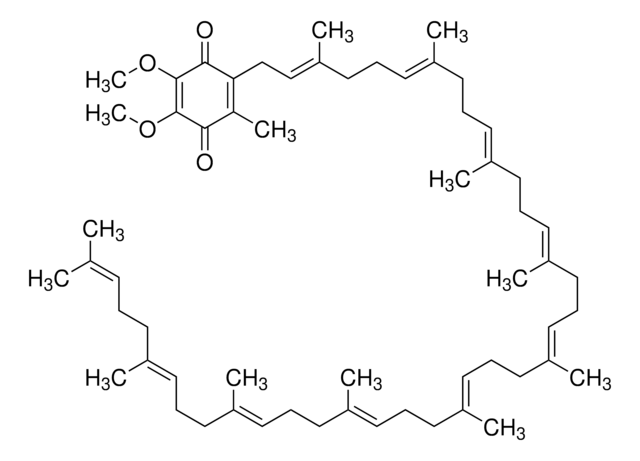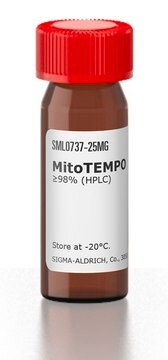D7783
Pyrroloquinoline quinone
≥95.0% (HPLC)
Synonyme(s) :
4,5-Dihydro-4,5-dioxo-1H-pyrrolo[2,3-f]quinoline-2,7,9-tricarboxylic acid, Methoxatin, PQQ
About This Item
Produits recommandés
Source biologique
synthetic
Pureté
≥95.0% (HPLC)
Forme
powder
Technique(s)
HPLC: suitable
Couleur
red to deep red
Température de stockage
2-8°C
Chaîne SMILES
OC(=O)c1cc(C(O)=O)c-2c(n1)C(=O)C(=O)c3cc([nH]c-23)C(O)=O
InChI
1S/C14H6N2O8/c17-10-4-2-6(14(23)24)15-8(4)7-3(12(19)20)1-5(13(21)22)16-9(7)11(10)18/h1-2,15H,(H,19,20)(H,21,22)(H,23,24)
Clé InChI
MMXZSJMASHPLLR-UHFFFAOYSA-N
Vous recherchez des produits similaires ? Visite Guide de comparaison des produits
Description générale
Application
- as a component of nanocurcumin formulation (NCF), to study its therapeutic effect on ameliorate hypoxia-induced stress in hypertrophied cardiomyocytes
- as a standard in fluorescence analysis
- to test its efficiency in suppressing restrained oxidative stress and hepatic fibrogenesis in mouse models
Actions biochimiques/physiologiques
Code de la classe de stockage
11 - Combustible Solids
Classe de danger pour l'eau (WGK)
WGK 3
Point d'éclair (°F)
Not applicable
Point d'éclair (°C)
Not applicable
Équipement de protection individuelle
Eyeshields, Gloves, type N95 (US)
Certificats d'analyse (COA)
Recherchez un Certificats d'analyse (COA) en saisissant le numéro de lot du produit. Les numéros de lot figurent sur l'étiquette du produit après les mots "Lot" ou "Batch".
Déjà en possession de ce produit ?
Retrouvez la documentation relative aux produits que vous avez récemment achetés dans la Bibliothèque de documents.
Les clients ont également consulté
Notre équipe de scientifiques dispose d'une expérience dans tous les secteurs de la recherche, notamment en sciences de la vie, science des matériaux, synthèse chimique, chromatographie, analyse et dans de nombreux autres domaines..
Contacter notre Service technique












